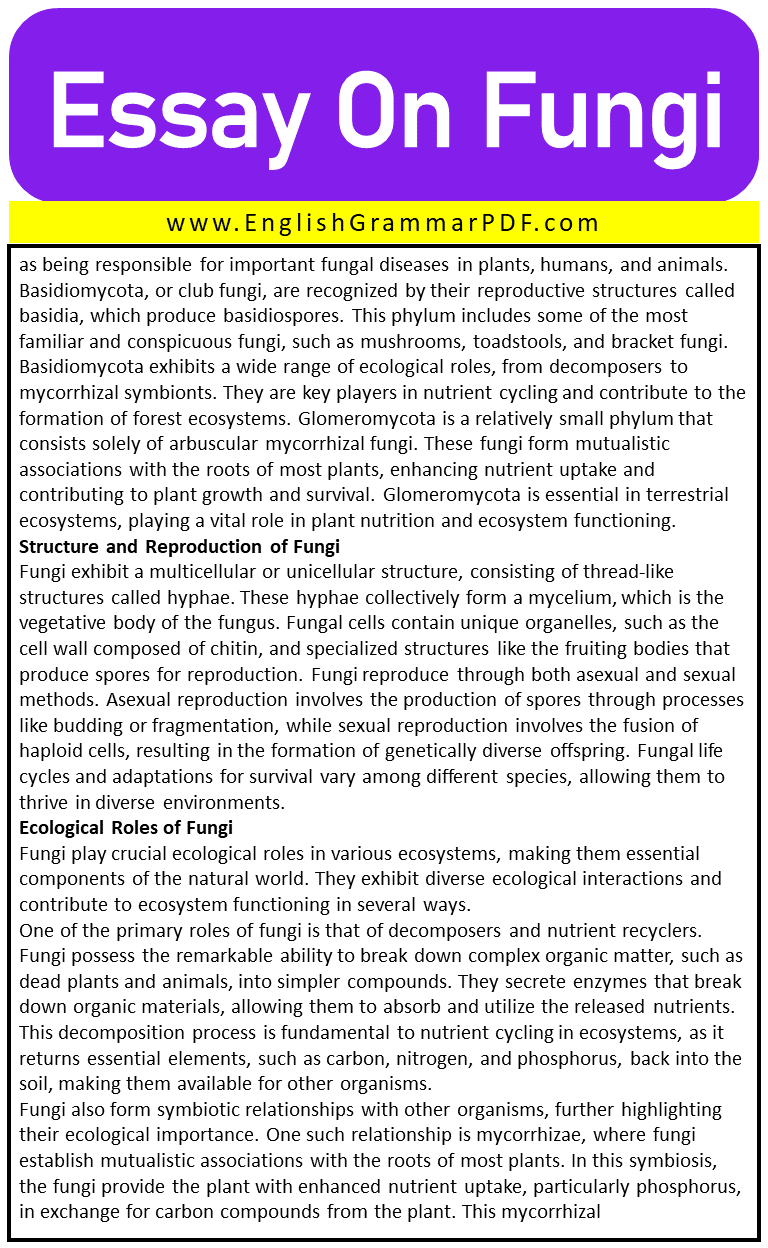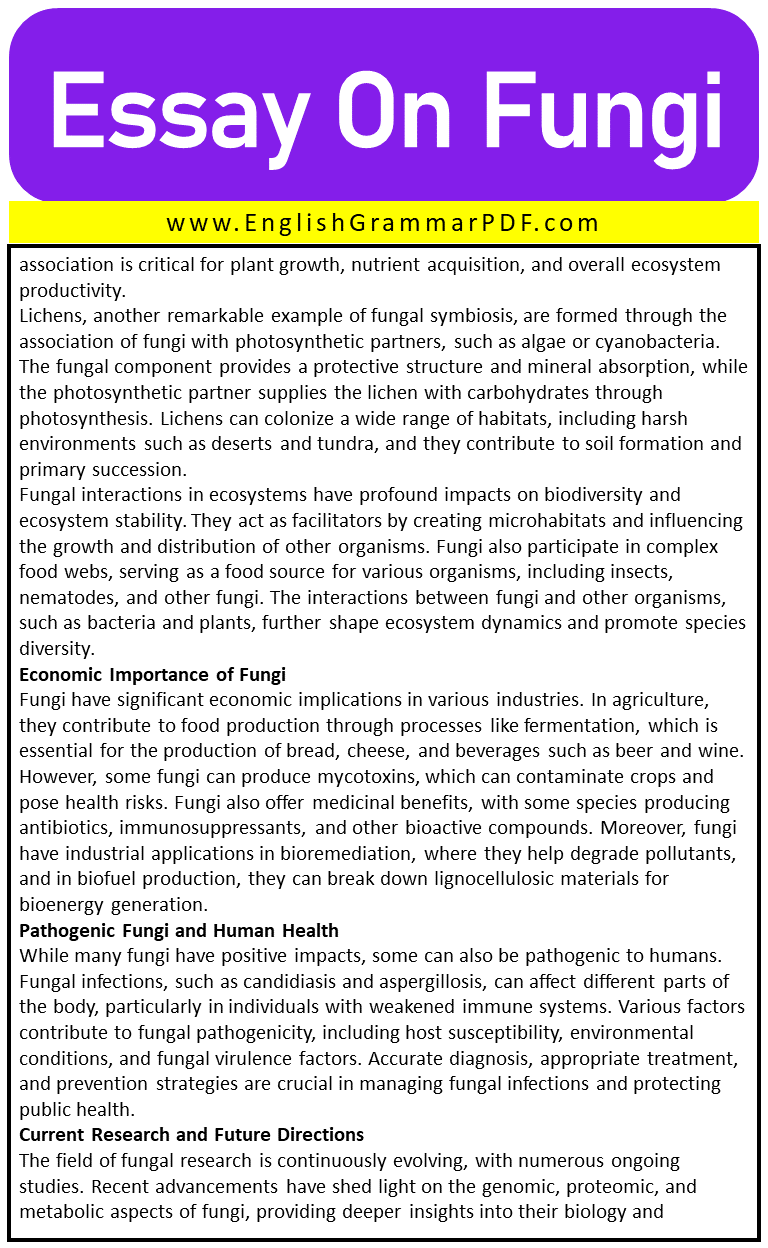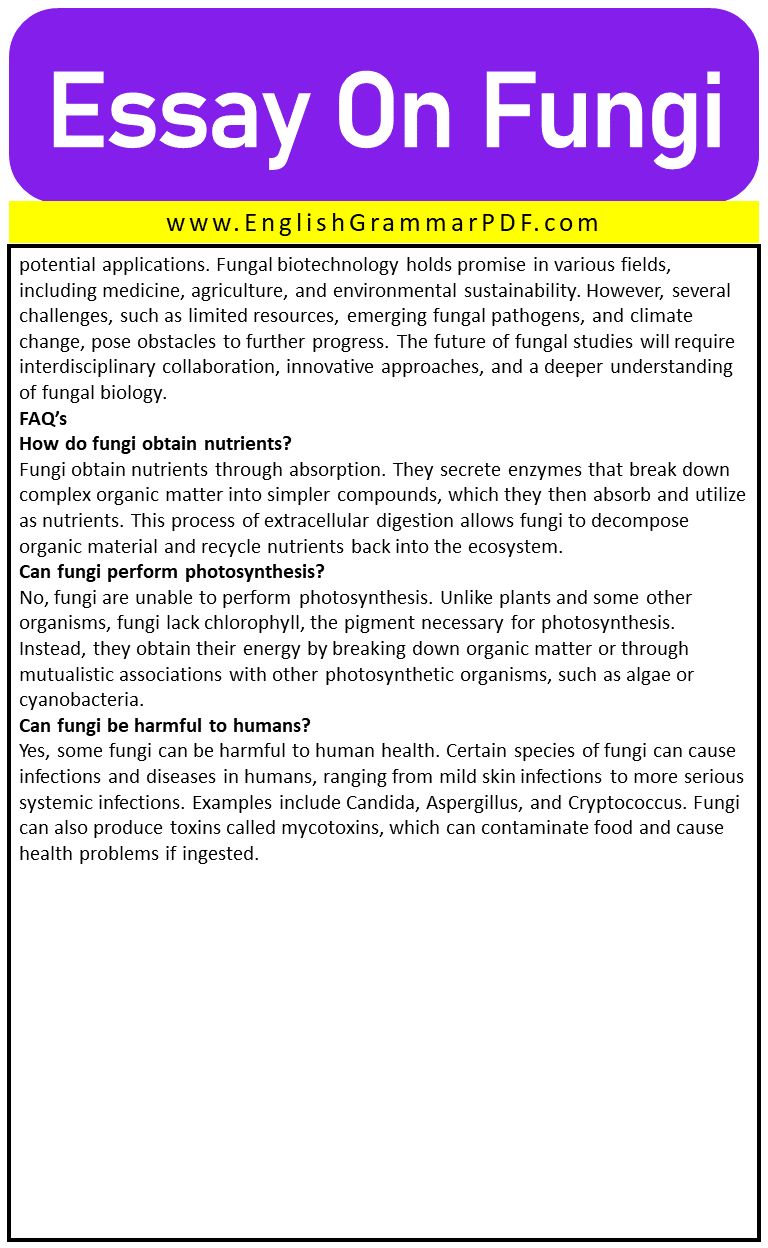Essay On Fungi
Outline of Essay:
- Introduction
- Classification and Diversity of Fungi
- Structure and Reproduction of Fungi
- Ecological Roles of Fungi
- Economic Importance of Fungi
- Pathogenic Fungi and Human Health
- Current Research and Future Directions
Introduction
Fungi are a diverse group of organisms that play vital roles in the natural world. They are eukaryotic organisms characterized by their unique mode of obtaining nutrients through absorption. Fungi exist in various habitats, from the depths of the ocean to the highest mountain peaks, and their presence is essential for ecosystem functioning. This essay aims to explore the fascinating world of fungi, discussing their classification, structure, reproduction, ecological roles, economic importance, impact on human health, and the current state of research in the field.
Classification and Diversity of Fungi
Fungi, as a kingdom of organisms, display remarkable diversity in their classification and characteristics. They are classified into five major phyla: Chytridiomycota, Zygomycota, Ascomycota, Basidiomycota, and Glomeromycota. Each phylum possesses distinct characteristics that set them apart from one another and contribute to their ecological roles and adaptations.
Chytridiomycota, the most primitive phylum of fungi, includes aquatic organisms with flagellated spores known as zoospores. These fungi can be found in diverse habitats, including freshwater and marine environments. Chytridiomycota is essential decomposers, breaking down complex organic matter in aquatic ecosystems and contributing to nutrient cycling. Zygomycota fungi are characterized by their ability to form zygospores during sexual reproduction. They are commonly found in soil, decaying organic matter, and as parasites of plants, insects, and other fungi. Zygomycota plays crucial roles in nutrient recycling and is significant plant pathogens, causing diseases such as fruit rots and blights.
Ascomycota, or sac fungi, are the largest phylum of fungi, encompassing a wide range of species. They are characterized by their reproductive structures called ascospores, which are formed within sac-like structures called asci. Ascomycota displays incredible diversity, with representatives such as yeasts, moulds, and truffles. They can be found in various environments, including terrestrial, freshwater, and marine habitats. Ascomycota is involved in crucial ecological interactions, such as mycorrhizal associations with plant roots, as well as being responsible for important fungal diseases in plants, humans, and animals.
Basidiomycota, or club fungi, are recognized by their reproductive structures called basidia, which produce basidiospores. This phylum includes some of the most familiar and conspicuous fungi, such as mushrooms, toadstools, and bracket fungi. Basidiomycota exhibits a wide range of ecological roles, from decomposers to mycorrhizal symbionts. They are key players in nutrient cycling and contribute to the formation of forest ecosystems. Glomeromycota is a relatively small phylum that consists solely of arbuscular mycorrhizal fungi. These fungi form mutualistic associations with the roots of most plants, enhancing nutrient uptake and contributing to plant growth and survival. Glomeromycota is essential in terrestrial ecosystems, playing a vital role in plant nutrition and ecosystem functioning.
Structure and Reproduction of Fungi
Fungi exhibit a multicellular or unicellular structure, consisting of thread-like structures called hyphae. These hyphae collectively form a mycelium, which is the vegetative body of the fungus. Fungal cells contain unique organelles, such as the cell wall composed of chitin, and specialized structures like the fruiting bodies that produce spores for reproduction. Fungi reproduce through both asexual and sexual methods. Asexual reproduction involves the production of spores through processes like budding or fragmentation, while sexual reproduction involves the fusion of haploid cells, resulting in the formation of genetically diverse offspring. Fungal life cycles and adaptations for survival vary among different species, allowing them to thrive in diverse environments.
Ecological Roles of Fungi
Fungi play crucial ecological roles in various ecosystems, making them essential components of the natural world. They exhibit diverse ecological interactions and contribute to ecosystem functioning in several ways.
One of the primary roles of fungi is that of decomposers and nutrient recyclers. Fungi possess the remarkable ability to break down complex organic matter, such as dead plants and animals, into simpler compounds. They secrete enzymes that break down organic materials, allowing them to absorb and utilize the released nutrients. This decomposition process is fundamental to nutrient cycling in ecosystems, as it returns essential elements, such as carbon, nitrogen, and phosphorus, back into the soil, making them available for other organisms.
Fungi also form symbiotic relationships with other organisms, further highlighting their ecological importance. One such relationship is mycorrhizae, where fungi establish mutualistic associations with the roots of most plants. In this symbiosis, the fungi provide the plant with enhanced nutrient uptake, particularly phosphorus, in exchange for carbon compounds from the plant. This mycorrhizal association is critical for plant growth, nutrient acquisition, and overall ecosystem productivity.
Lichens, another remarkable example of fungal symbiosis, are formed through the association of fungi with photosynthetic partners, such as algae or cyanobacteria. The fungal component provides a protective structure and mineral absorption, while the photosynthetic partner supplies the lichen with carbohydrates through photosynthesis. Lichens can colonize a wide range of habitats, including harsh environments such as deserts and tundra, and they contribute to soil formation and primary succession.
Fungal interactions in ecosystems have profound impacts on biodiversity and ecosystem stability. They act as facilitators by creating microhabitats and influencing the growth and distribution of other organisms. Fungi also participate in complex food webs, serving as a food source for various organisms, including insects, nematodes, and other fungi. The interactions between fungi and other organisms, such as bacteria and plants, further shape ecosystem dynamics and promote species diversity.
Economic Importance of Fungi
Fungi have significant economic implications in various industries. In agriculture, they contribute to food production through processes like fermentation, which is essential for the production of bread, cheese, and beverages such as beer and wine. However, some fungi can produce mycotoxins, which can contaminate crops and pose health risks. Fungi also offer medicinal benefits, with some species producing antibiotics, immunosuppressants, and other bioactive compounds. Moreover, fungi have industrial applications in bioremediation, where they help degrade pollutants, and in biofuel production, they can break down lignocellulosic materials for bioenergy generation.
Pathogenic Fungi and Human Health
While many fungi have positive impacts, some can also be pathogenic to humans. Fungal infections, such as candidiasis and aspergillosis, can affect different parts of the body, particularly in individuals with weakened immune systems. Various factors contribute to fungal pathogenicity, including host susceptibility, environmental conditions, and fungal virulence factors. Accurate diagnosis, appropriate treatment, and prevention strategies are crucial in managing fungal infections and protecting public health.
Current Research and Future Directions
The field of fungal research is continuously evolving, with numerous ongoing studies. Recent advancements have shed light on the genomic, proteomic, and metabolic aspects of fungi, providing deeper insights into their biology and potential applications. Fungal biotechnology holds promise in various fields, including medicine, agriculture, and environmental sustainability. However, several challenges, such as limited resources, emerging fungal pathogens, and climate change, pose obstacles to further progress. The future of fungal studies will require interdisciplinary collaboration, innovative approaches, and a deeper understanding of fungal biology.
FAQ’s
How do fungi obtain nutrients?
Fungi obtain nutrients through absorption. They secrete enzymes that break down complex organic matter into simpler compounds, which they then absorb and utilize as nutrients. This process of extracellular digestion allows fungi to decompose organic material and recycle nutrients back into the ecosystem.
Can fungi perform photosynthesis?
No, fungi are unable to perform photosynthesis. Unlike plants and some other organisms, fungi lack chlorophyll, the pigment necessary for photosynthesis. Instead, they obtain their energy by breaking down organic matter or through mutualistic associations with other photosynthetic organisms, such as algae or cyanobacteria.
Can fungi be harmful to humans?
Yes, some fungi can be harmful to human health. Certain species of fungi can cause infections and diseases in humans, ranging from mild skin infections to more serious systemic infections. Examples include Candida, Aspergillus, and Cryptococcus. Fungi can also produce toxins called mycotoxins, which can contaminate food and cause health problems if ingested.
Explore More Essays:
Download the PDF of the Essay:







